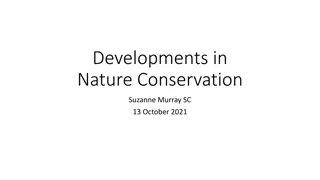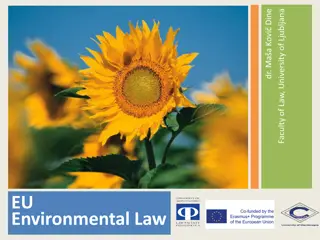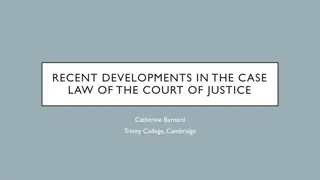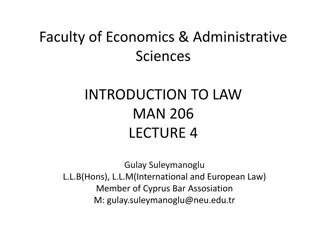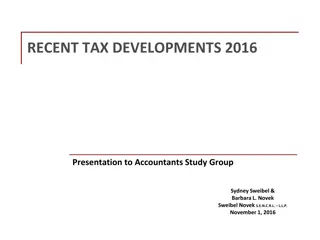Recent Developments in Public Participation in Environmental Law
A brief overview of key recent developments in public participation within environmental law, focusing on the increasing relevance of public participation in environmental litigation and the complexities arising from obligations under the Aarhus Convention and EU Law. The discussion also highlights the challenges in incorporating the Aarhus Convention into Irish domestic law and the significance of relying on relevant EU law in legal proceedings.
Uploaded on Mar 17, 2025 | 1 Views
Download Presentation

Please find below an Image/Link to download the presentation.
The content on the website is provided AS IS for your information and personal use only. It may not be sold, licensed, or shared on other websites without obtaining consent from the author.If you encounter any issues during the download, it is possible that the publisher has removed the file from their server.
You are allowed to download the files provided on this website for personal or commercial use, subject to the condition that they are used lawfully. All files are the property of their respective owners.
The content on the website is provided AS IS for your information and personal use only. It may not be sold, licensed, or shared on other websites without obtaining consent from the author.
E N D
Presentation Transcript
Fungi by Debsankar Das
Introduction Fungi (singular: fungus) are a diverse group of eukaryotic organisms that belong to their own kingdom, distinct from plants, animals, and bacteria. They play crucial roles in various ecosystems and have significant impacts on human life. Fungi come in various forms, ranging from microscopic single-celled organisms like yeasts to complex multicellular structures like mushrooms.
Occurence Fungi are diverse eukaryotic organisms found worldwide. Examples include Penicillium (soil), Aspergillus (soil and indoor), Saccharomyces cerevisiae (fruit and vegetables), Armillaria mellea (parasitic), Morchella spp. (forest), Candida albicans (human microbiota), and more. They play essential roles in nature and have practical uses in medicine, food production, and industry.
Characteristics 1. Fungi are eukaryotic, non-vascular, non-motile and heterotrophic organisms. 2. They may be unicellular or filamentous. 3. They reproduce by means of spores. 4. Fungi exhibit the phenomenon of alternation of generation. 5. Fungi lack chlorophyll and hence cannot perform photosynthesis. 6. Fungi store their food in the form of starch. 7. Biosynthesis of chitin occurs in fungi. 8. The nuclei of the fungi are very small. 9. The fungi have no embryonic stage. They develop from the spores. 10.The mode of reproduction is sexual or asexual. 11.Some fungi are parasitic and can infect the host. 12.Fungi produce a chemical called pheromone which leads to sexual reproduction in fungi. 13.Examples include mushrooms, moulds and yeast.
Structure 1. Almost all the fungi have a filamentous structure except the yeast cells. 2. They can be either single-celled or multicellular organisms. 3. Fungi consist of long thread-like structures known as hyphae. These hyphae together form a mesh-like structure called mycelium. 4. Fungi possess a cell wall which is made up of chitin and polysaccharides. 5. The cell wall comprises a protoplast, which is differentiated into other cell parts such as cell membrane, cytoplasm, cell organelles and nuclei. 6. The nucleus is dense, clear, with chromatin threads. The nucleus is surrounded by a nuclear membrane.
Reproduction Vegetative reproduction in fungi This takes place by budding, fission and fragmentation. Asexual reproduction This takes place with the help of spores called conidia or zoospores, or sporangiospores. Sexual reproduction This occurs by ascospores, basidiospores, and oospores. The conventional mode of sexual reproduction is not always observed in the kingdom Fungi. In some fungi, the fusion of two haploid hyphae does not result in the formation of a diploid cell. In such cases, there appears an intermediate stage called the dikaryophase. This stage is followed by the formation of diploid cells.






